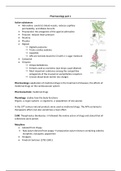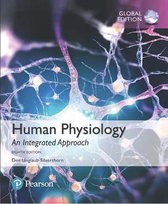Pharmacology part 1
Active substances
• Adrenaline: constricts blood vessels, reduces capillary
permeability, and dilates bronchi.
• Propranolol: the antagonist of the agonist adrenaline.
• Prazosin: reduces heart pressure
• Nicotine
• Placebo
• Digoxin
Digitalis purpurea
Treats cardiac oedema
Lipophilic
APA are steroids bound to C3 with ≥ 1 sugar molecule
• Carbachol
• Atropine
Atropa belladonna
Extracts used as cosmetics (eye drops: pupil dilation)
Most important substance among the competitive
antagonists of the muscarinic acetylcholine receptors
Crosses blood-brain barrier (no charge)
Pharmacology: application of medicinal drugs in the treatment of diseases; the effects of
medicinal drugs on the cardiovascular system
Pharmaceuticals: medicinal drugs
Physiology: studies how the body functions
Organs → organ systems → organisms → populations of one species
In the 19th century natural products were used as medicinal drugs. The APA contained a
therapeutic effect, but also sometimes a toxic effect.
1500: Theophrastus Bombastus → followed the motive action of drugs and stated that all
substances were poison.
Morphine
• Isolated from Poppy
• Raw opium derived from poppy → preparation opium tincture containing codeine,
morphine, noscapine, papaverine
• Analgesic
• Friedrich Sertüner (1783-1841)
,Aims of isolating pharmaceuticals are:
• Pharmacodynamics: analysis of the biological effect of pharmaceuticals
• Pharmacokinetics: analysis of the fate of APA in the body
• Identification APA
• Guarantee dose remains exact unchanged by using the isolated pharmacon in
treatments
• Option of chemical synthesis; synthesis of pharmaceuticals with more favorable
pharmacological characteristics
• Altering the chemical structure; medicinal drugs that have a stronger effect
Pharmacokinetics
• Resorption
Oral
• Good patient compliance
• Liver → stomach → intestine → blood stream
• Packaging of drug because of the acidic stomach
Inhalation
Respiratory system: bronchial asthma
Low systemic load: which makes local application possible
• Distribution
Oral: self-medication
• First pass effect
Portal vein system: blood vessel that carries the drug with the blood from the
GI tract to the liver.
Inhalation
Topical (at particular side)
Drug enters via the superior vena cava (bovenste holle ader) the right part of
the heart
Transdermal
Sublingual and buccal: matured people with heart diseases: limitations of
oxygen supply
Rectal
• Storage
• Biotransformation in the liver
• Excretion by the kidneys
Pharmacokinetics: blood-tissue barriers
• Blood-brain barrier separates the bloodstream from the extracellular fluid of the
brain located outside the cells
Prevents water-soluble molecules and small particles penetrating in the brain
fluid
Allows fat-soluble (lipophilic) small molecules, gases and hormones
The cells of the barrier have active transport mechanisms for metabolic
products such as glucose
• Central effect: blood-brain barrier can be crossed (permeable)
• Peripheral effect: blood-brain barrier cannot be crossed (impermeable)
, • Blood-heart muscle barrier: shelted
• Blood-liver barrier: open because of biotransformation
• Blood-pancreas barrier: open for enzymes secreted to transform food
Pharmacokinetics: Plasma proteins
Albumin
• Unspecific binding
• Low affinity APA for albumin
• High affinity for specific binding sites (receptors)
• For most pharmaceuticals the albumin receptors are far from saturated at
therapeutic concentrations
• Drug bound to albumin → inactive, drug acts over a long time, slow elimination
Presystemic elimination: first-pass effect
• High presystemic elimination required with steroids (propranolol)
• Most biotransformation takes place in the liver and little in the lungs and the
intestinal wall.
• Low systemic load
• Glucocorticosteroids with treatment for asthma
Pharmacodynamics
• Binding to receptors (proteins)
• Biological effect
Increased sensitivity causes a decrease in the safety margin of therapeutic effect and toxic
effect.
Quantification: effects of medicinal drugs
• Vasoconstriction: blood vessel constricts when higher levels of drug concentrations
are present
• EC50: effective concentration to achieve 50% biological effect: half-maximal
response/effect obtained
• Parts of organ or vessels are used.
• Trouble to see the biological effect with a linear scale.
• Logarithmic scale used to get the maximum possible effect and the effective
concentration to achieve 50% of the biological effect.
Concentration-binding curves
• To elicit an effect of a drug, the drug molecules must be bound to an receptor of the
effector organ.
• The affinity and number of binding sites (receptors) is analysed by a membrane
suspension of different tissues.
• Receptors retain their properties during cell homogenation
• Approach: Organ → homogenization → centrifugation → membrane suspension →
add radiolabeled drug → mix and incubation → measure affinity drug to receptor
• The organ function is destroyed and can’t be studied anymore
, • As binding sites approach saturation, the number of free sites decreases and the
increment in binding is no longer proportional to the increase in concentration
• No physiologidcal response
• Characteristics of receptor-binding experiments: saturability, specificity, binding
affinity, no discrimination between agonist and antagonist
Linear: point on the graph indicated the
saturation
Logaratihmic: point on graph indicated
the binding
Agonist
• Carbachol (acts like Ach, but more stable), acetylcholine (ACh, Sir Henry Dale)
• By binding to the receptor, the conformation changes and induces a biological
response
• Intrinsic biological activity: active conformational change
• Full agonist: induces a full biological response
• Partial agonist: similar to partial antagonist. Possessing equal affinity as the full
agonist but less ability to activate the receptor and the associated signal transduction
steps (iless intrinsic activity, reduced coupling efficiency). So, will produce a
smaller maximal effect (biological response) even if all receptors are
occupied.
• Mimetic drug
• Stimulation of a cellular response (efficacy)
Antagonist
• binds to receptor → no biological response
• When an antagonist binds, the action of an agonist is blocked, also otherwise.
• No intrinsic activity, no cellular response
• Blocker, lytic drugs
• Competitive antagonism:
reversible active site binding (most drugs)
shifts the agonists concentration-effect curve to the
right, more needed to get the same response, without
having an effect on the agonist’s maximum effect.
• Functional antagonism
Two agonists acting via different receptors affect the same variable (e.g.,
luminal diameter of bronchi) in opposite directions (epinephrine → dilation;
histamine → constriction).
Two different receptors in the same cell of the lung airway smooth muscle
cell: receptor for acetylcholine and receptor for adrenaline (sympathetic
system)
, ▪When adrenaline binds the β2-receptor: ATP → cAMP → Protein
kinase A→ myosin becomes less active → vasodilation, relaxation
smooth muscle
▪ When acetylcholine binds the
muscarinic acetylcholine receptor M3:
IP3 → Ca2+ → myosin → actin →
contraction
Modulation heartrate: m3 receptor expresses
M2 receptor → reduces heartrate down to
normal sinus rhythm after positive
stimulatory actions of the parasympathetic
nervous system
Rational pharmacotherapy is based on the interaction of pharmaceuticals with substances
that are part of a cascade.
Acetylcholine
• The more concentration, the more biological effect.
• more acetylcholine → the more vasodilation of the blood vessels → higher reduction
of the blood pressure.
• Atropine is the antagonist of the agonist acetylcholine.
Receptor types – time scale
• Ligand-gated ion channels (ionotropic receptors): milliseconds
Nicotinic acetylcholine receptors: composed of 5 peptides which contains 4
transmembrane domains. The 2 α-domains bind acetylcholine (and nicotine)
ACh Binds → channel opens → entry na+, exit k+ → membrane depolarization
→ action potential → activation cells
Nm subtype: muscular
Nn subtype: neuronal: consist only α-subunit and β-subunit
• GPC: seconds
Stimulate/inhibit signaling pass way
Acetylcholine binds besides to ion channels also to GPC.
G-protein can bind a GTP → 7-helical agonist (acetylcholine/adrenaline) binds
to receptor → G protein on the innerleaflet dissociates α-subunit from the β
and γ → activation effector proteins via the via Gα and Gβγ subunits →
downstream signaling
Receptors for hormones/neurotranmitters/mediators
▪ Muscarinic ACh receptors: M1, M2, M3, M4, M5
, ▪ Adrenoreceptors: α1, α2, β1, β2, β3
Gs:
Stimulator
y G-
protein
Gi:
inhibiting
G-protein,
inhibits
protein
kinase A
Adenylyl/adenylate cyclase
• All beta receptors use this pass way (heart/liver/lung)
• Activation of β-adrenoceptor, which acts via Gs protein,
stimulates the cAMP production
• activation of M2-receptor, which acts via a Gi protein,
inhibits cAMP production
• Forskolin: direct stimulation of adenylyl cyclase, i.e. without receptor activation!
• Theophylline: inhibition of cAMP-specific phosphodiesterases
Guanylyl cyclase
• Often part of the G protein
• Vasodilators:
NO, nitrates, nitric oxide
EDRF = endothelium-derived relaxing factor
• Blood vessels are sensitive to acetylcholine. When acetylcholine
binds the M3 muscarinic receptor on the endothelial cell, Ca2+
increases, NO is activated, diffuses in the smooth muscle cells and
activates guanylyl cyclase, which produces cGMP from GTP, so
relaxation blood vessels.
• NOS: nitric oxide synthase
• Sildenafil (Viagra) is blocking the degradation cGMP and thereby
relaxing the blood vessels.
What does artherosclerosis lead to?
A reduced production of NO (endothelium-derived relaxing factor) in endothelial cells,
reduced activation of guanylyl cyclase in smooth muscle cells and reduced relaxation of
vascular smooth muscle cells. Fat, calcium and cholesterol builds up inside the arteries.
,• Ligand-gated enzymes = kinase-linked receptors
Insulin receptor
▪ glucose homeostasis
▪ cellular proliferation
▪ 2 peptides with an intracellular tyrosine kinase
▪ brain, muscle, adipose tissue
Pathophysiology
▪ diabetes mellitus
▪ metabolic syndrome
Functions: Getting rid of glucose in the bloodstream /
growth / gene transcription
• Protein synthesis-regulating receptors / nuclear receptors
Intracellular receptors
Steroids and thyroid hormone
Ligand binds receptor in the cell,
no charge and lipophilic
, Neurons pharmacology
Collission coupling theory of signalling
The central nervous system
- Receptors act on the part of autonomic nervous system
Parasympathetic: using acetylcholine
Sympathetic: adrenaline, noradrenaline
Smooth muscle cells in airways: determine breathing activity
Smooth muscle cells in blood vessels
Glands: nervous/run
Pancreas function also regulated by the autonomic nervous system
adipose tissue: associated to metabolic syndrome/activation
Neurons / nerve cell
- Carry electrical signals
- Axons: Long processes that extend outward from the nerve cell body carrying
outgoing information
- Dendrites: Long processes that extend outward from the nerve cell body receiving
incoming information
- Sensory (afferent) neurons
➢ Carry information about temperature, pressure, light, smell to the CNS
➢ bipolar: Eye and nose neurons. Single axon, single dendrite coming off the
cell body
➢ pseudounipolar: peripheral neurons located close to the CNS. They have the
cell body on one side of a single long process called the axon. During
development, the dendrites fused and became part of the axon.
- Inter(connecting)neurons of CNS:
➢ anaxonic: no apparent axon, have numbered branched dendrites
➢ complex branching processes → communication with lots of other neurons
- efferent neurons (somatic motor and autonomic)
➢ multipolar: model neuron
➢ schwann cells: contain myelin (protein), which isolates the axon to increase
the rate at which information is passed along the axon.
• Too little schwann cells: multiple sclerosis
➢ axons divide into branches called collaterals
➢ enlarged endings: axon terminals
➢ autonomic neurons: varicosities (enlarged regions)
➢ axon terminals and varicosities store and release neurotransmitters






